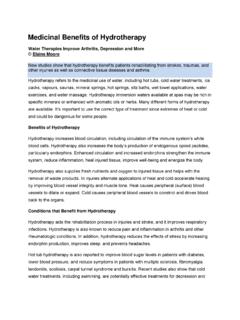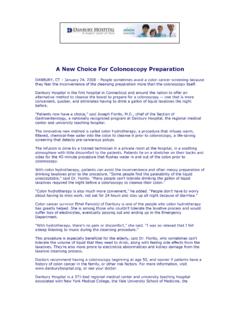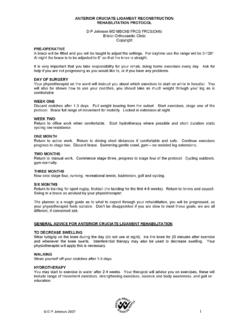Transcription of Hip arthroscopy - Rehab Programme - Ernest …
1 Hip arthroscopy Rehabilitation Programme The London Hip arthroscopy Centre The Wellington Hospital, Wellington Place, London NW8 9LE. Telephone: 020 7483 5589. 1. Post-operative Advice following Hip arthroscopy Following your operation, you will be seen by our in-patient physiotherapist who will explain your operation to you and advise you on your home exercises. Before you return home, you will be taught how to mobilise with elbow crutches safely as well as managing stairs. You will be self managing at home for the first 2 weeks following your discharge.
2 It is important that you continue on with the exercise Programme provided during this time. WALKING AND MOBILITY. After your surgery you will be instructed by your physiotherapist to partial weight bear through the operated limb for up to 6 weeks as advised by your surgeon. Your physiotherapist will issue you with crutches if required, which you can purchase from the hospital. Your physiotherapist will advise you on when you can progress to full weight bearing, which will be according to your surgeon's instructions.
3 You should discard the crutches only when you are able to walk full weight bearing with no limp. PAIN. The hip can be irritable during the first six weeks after the procedure. The nurse will issue you with painkillers to take home and explain the usage to you. It is advisable to use them as necessary to keep yourself as pain-free as possible. This will allow you to walk and exercise comfortably. Ice packs can also be used to help reduce pain and swelling. Note: do not apply ice directly to the skin. Wrap your ice pack in a towel first.
4 Apply the ice pack to the affected area for 20 minutes. This can be repeated three times per day. STAIRS. Always use the banister where possible. Going Up As you go upstairs, hold the banister in one hand and your crutch in the other. Put your non-operated leg up first, then the operated leg onto the same step. Going Down As you go downstairs, place your crutch in front of you first followed by your operated leg then non operated leg. 2. JOINT STIFFNESS. The arthroscopic procedure can inflame the joint for a short period of time afterwards.
5 This is usually experienced as stiffness' and discomfort on movement. Your physiotherapy exercises are designed to combat this and minimise the duration of the restriction of movement. Your aim is to regain the full pain-free range of movement of the joint as soon as you can. EXERCISES. Your physiotherapist will teach you some hip exercises while you are in the hospital. After discharge it is important to continue on with these exercises until you attend outpatient physiotherapy to maximise your hip strength and movement.
6 Hydrotherapy can be used for rehabilitation after the wound is healed. REST. It is advisable to limit the amount of walking to a minimum for the first 4 days post- operatively, and then gradually increase daily as tolerated. As well as walking and doing your exercises, it is also important that you rest your leg. Your activities should be gradually increased, keeping in mind that the hip can be irritable for the first 6. weeks. Use pain and swelling as a guide of how much rest your hip needs. You are not allowed to do any high impact sport or activities for 6 weeks following your operation.
7 This includes running and jumping. If you have had micro fracturing, running is not to be commenced until 13 weeks post surgery. WOUND CARE. Your nurse will advise you regarding wound care and dressings required. It is very important to keep the wound DRY until the wound has healed. This is a route for micro-organisms to enter the joint and cause an infection, and every precaution is taken to prevent this from happening. It is advisable that you shower for the first two weeks post-operatively and do not have an immersion bath.
8 WOUND OOZE. A small amount of old blood can leak from the wounds and stain the dressing. This is quite routine and nothing to be alarmed about. Any bleeding that is more extensive must be reported to the consultant or to the ward immediately. DRIVING. Driving is at the discretion of your consultant. This is generally one to two weeks following your surgery, as long as this does not cause any pain or discomfort and you are not taking strong medication. OUTPATIENT PHYSIOTHERAPY. It is extremely important that you continue with outpatient physiotherapy after your discharge.
9 This should be started following your follow-up visit with your consultant or after 2 weeks from following your home exercise Programme . This is important in order for you to progress further with your rehabilitation Programme . A list of local physiotherapists can be found using the following website 3. Hip arthroscopy Exercise Programme WEEK 1. ISOMETRIC EXERCISES. The following exercises can be done lying down on your back. Try to do the exercises twice per day. Repeat each exercise 20 times. Ankle pumps - Pump your ankles up and down for at least 20.
10 Repetitions, 2 times a day. Quads sets push your knees into the bed by tightening your thigh muscle hold for 5 seconds. Gluteal sets - tighten your buttock muscles hold for 5 seconds Transversus Abdominus - Draw belly button in towards spine without moving pelvis/spine hold while taking 5 breaths. Hip abduction - Lying on your back with hip and knees bent, place a belt around your thighs near your knees and push out against the belt hold 5 seconds STRETCHING EXERCISES. Do these exercises twice per day. Hold each stretch for 20 seconds and repeat 5.







